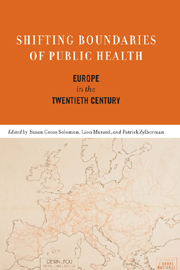Book contents
- Frontmatter
- Contents
- Preface
- Introduction
- Part One Place as Politics
- Part Two Carving Out the International
- Part Three Preserving the Local
- 6 Designs within Disorder: International Conferences on Rural Health Care and the Art of the Local, 1931–39
- 7 Contested Spaces: Models of Public Health in Occupied Germany
- 8 British Public Health and the Problem of Local Demographic Structure
- Part Four Navigating between International and Local
- Selected Bibliography
- List of Contributors
- Index
8 - British Public Health and the Problem of Local Demographic Structure
from Part Three - Preserving the Local
Published online by Cambridge University Press: 12 September 2012
- Frontmatter
- Contents
- Preface
- Introduction
- Part One Place as Politics
- Part Two Carving Out the International
- Part Three Preserving the Local
- 6 Designs within Disorder: International Conferences on Rural Health Care and the Art of the Local, 1931–39
- 7 Contested Spaces: Models of Public Health in Occupied Germany
- 8 British Public Health and the Problem of Local Demographic Structure
- Part Four Navigating between International and Local
- Selected Bibliography
- List of Contributors
- Index
Summary
“Demography,” as a recent critique of the discipline has observed, “offers its wares to a range of agencies.” The purpose of this chapter is to focus on demography as a realm of expert knowledge that has applications in the practice of one of these agencies, public health. By demography, we mean the study and analysis of population structure (age, sex, ethnicity, spatial distribution, and so on) and the dynamic components of fertility, marriage and divorce, migration, and mortality. We might assume that public health would be more concerned with the last of these components—mortality—than perhaps with the others, though practitioners working in reproductive and sexual health, and those addressing questions of (for example) refugee health justifiably might beg to differ. This chapter considers not only how, over the twentieth century, knowledge concerning three basic aspects of population—the total number of people, the age structure, and the male/female composition—was used in the evaluation of public health policy at the local level, but also how it shaped the measurement, calculation, and deployment of mortality rates in the practice of public health. The interplay between national policy and local implementation is an enduring theme in the history of public health. By moving between these ends of the spectrum, it is possible to comprehend the variable political meaning of, and sensitivity to, mortality rates as instruments of public health intelligence.
- Type
- Chapter
- Information
- Shifting Boundaries of Public HealthEurope in the Twentieth Century, pp. 205 - 228Publisher: Boydell & BrewerPrint publication year: 2008

